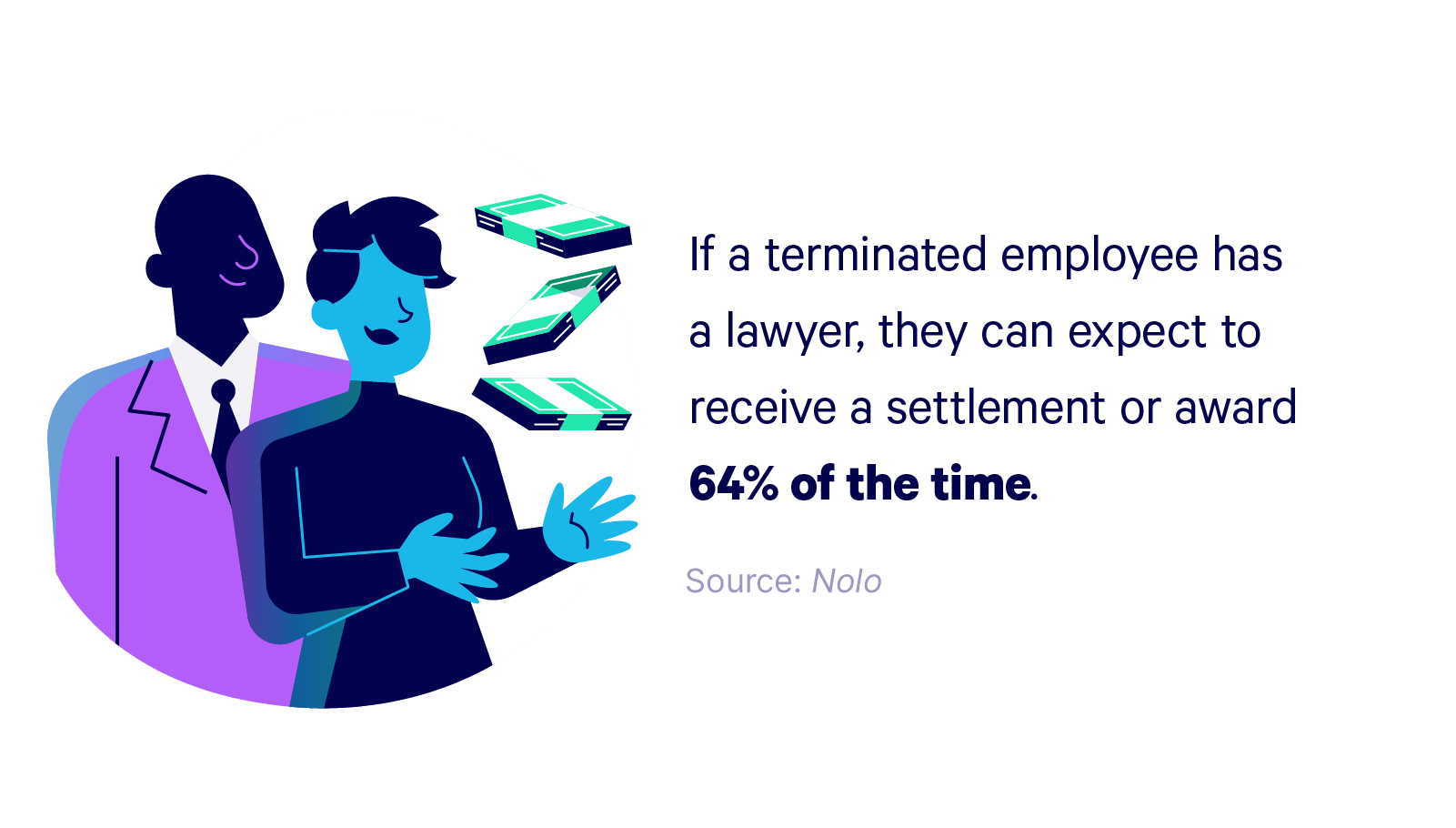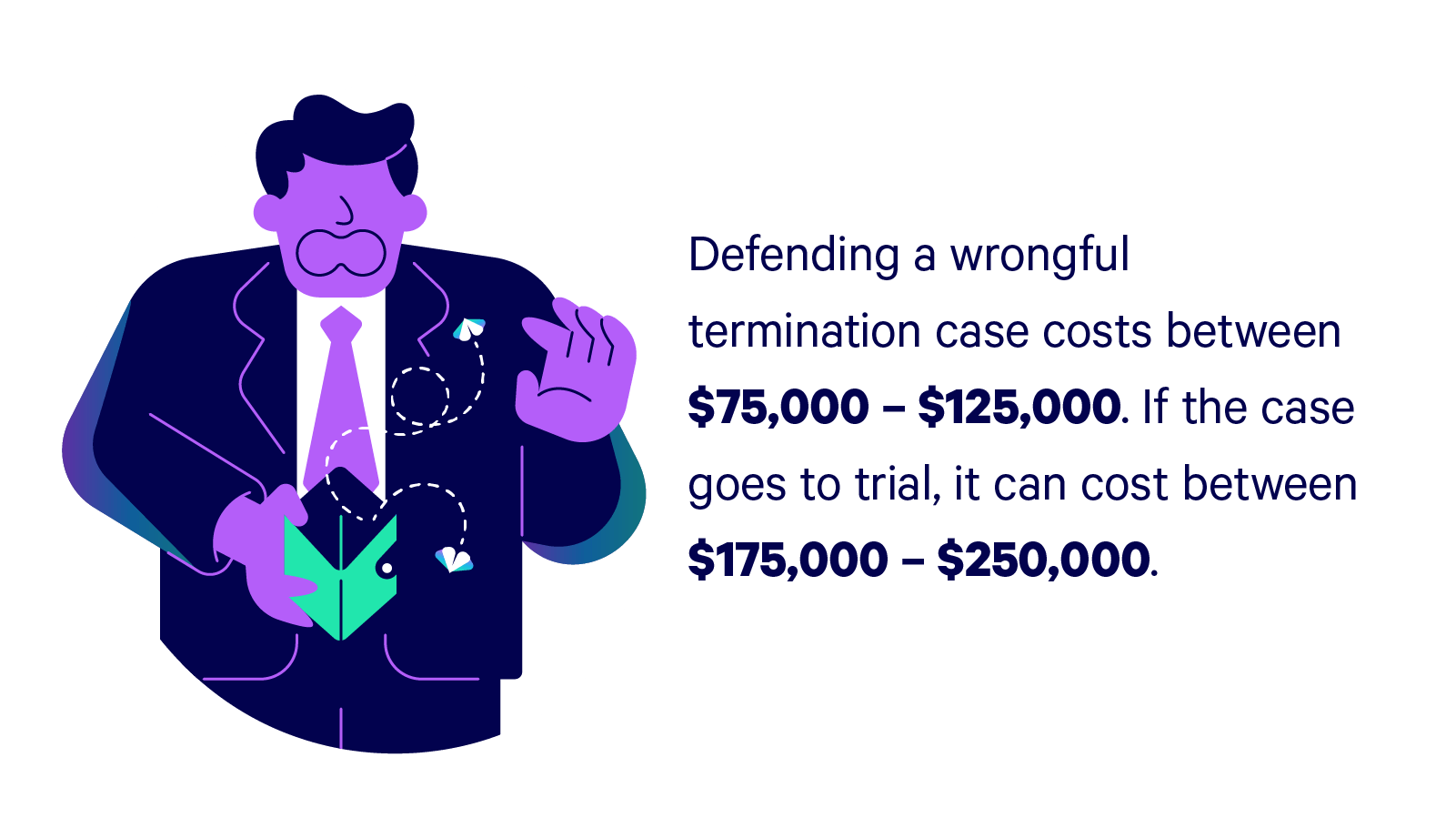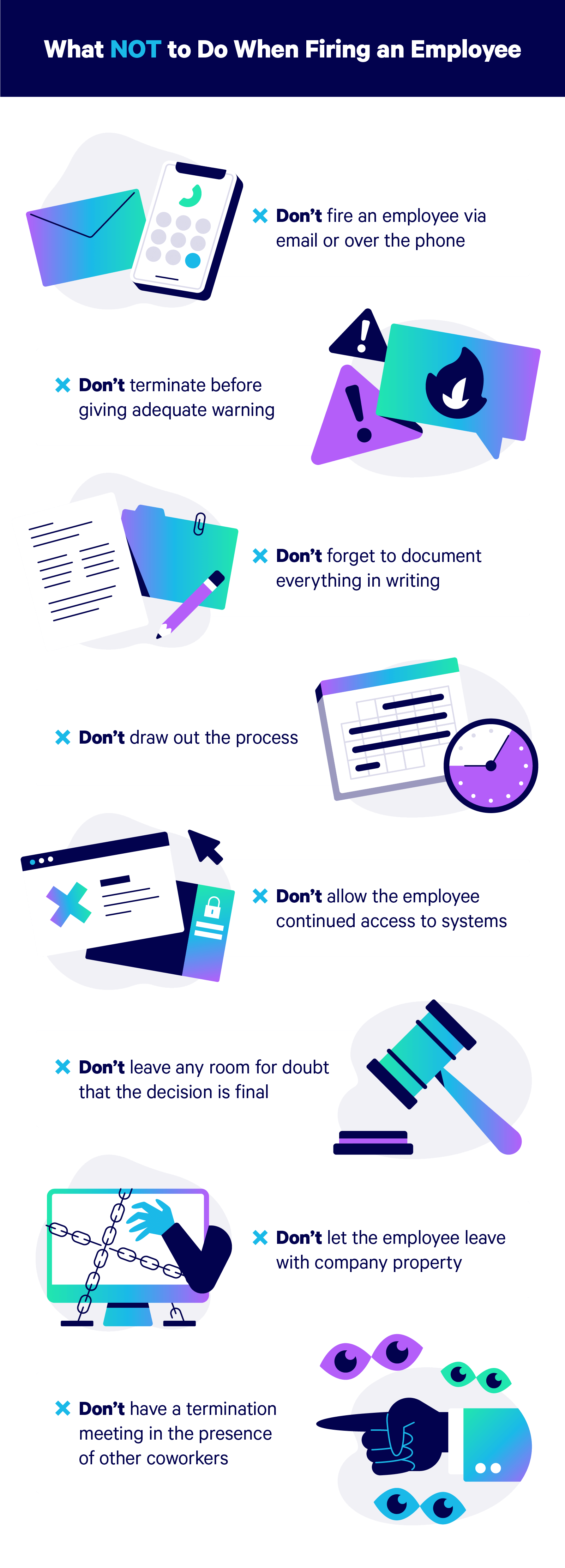
Table of Contents
Do you know how to terminate an employee properly? No one looks forward to the moment they have to tell an employee they’ve been let go. Even in the best of situations, terminating an employee is an awkward, unpleasant experience.
More importantly, firing an employee the wrong way can expose you and your company to a potential wrongful termination lawsuit.
If you’ve reached the conclusion that you need to fire someone on staff, it’s important to make sure you follow the correct legal processes to do so without opening yourself up to a potential lawsuit. Read on to find out exactly what you should and shouldn’t do when it comes to terminating an employee.

Get a comprehensive insurance policy in 15 minutes.
Get an instant quote to find out how little peace of mind can cost.
Steps on How to Terminate an Employee:
Do Your Research
Most states have “at-will employment” laws, which allow employers to terminate employees without explanation or warning unless specific terms were laid out in the hiring contract.
However, there are exceptions to this law that vary from state to state, and federal law prohibits firing an employee for certain specific reasons (like discrimination or retaliation) so it’s important to do your research before moving forward with a termination.
Exceptions to At-Will Termination
There are certain exceptions to state at-will employment laws that vary depending on what state you’re in. They include:
- Just Cause: If you put company guidelines in place or offer assurances to employees that they can only be fired for a “just cause,” this supersedes your right to at-will termination and you can be sued for violating your own company rules.
- Public Policy: In 42 states plus Washington, D.C., it’s illegal to fire an employee for behavior that’s protected by public policy or statute (like reporting workplace safety hazards or refusing to participate in criminal activity).
- Covenant of Good Faith: In a handful of states, companies can be sued for termination “in bad faith” – for example, terminating an employee to avoid paying retirement benefits.

Federal Termination Laws
Additionally, there are federal laws that prevent employers from terminating employees for specific reasons. Even if your company is located in an at-will termination state, it’s important to keep copious records leading up to termination of an employee in order to refute potential accusations of wrongful termination.
Discrimination
Federal law makes it illegal to fire an employee due to things like the employee’s race, gender, disability, religion, age, pregnancy status, immigration status, etc. Some states also have additional protections that add additional protection classes to this list, like sexual orientation and marital status.
Retaliation
It’s illegal to fire an employee in retaliation for engaging in any legally protected activity. Examples include:
- Reporting a workplace violation
- Refusing to participate in illegal activity
- Complaining about discrimination or harassment
- Cooperating in an investigation by the Equal Employment Opportunity Commission (EEOC)
- Taking legally-protected family leave
Refusal to Take a Lie Detector Test
It is illegal for most employers to fire a staffer for refusing to take a lie detector test, thanks to the federal Employee Polygraph Protection Act. (In many states, it’s illegal to administer polygraph tests in general.)
Reporting an OSHA Violation
The Occupational Safety and Health Act (OSHA) makes it illegal to fire workers for complaining about safety hazards or work conditions that violate state and federal regulations.
Establish Your Own Termination Standards
Most founders and CEOs pride themselves on establishing a company culture where employees are respectful and respected, and where communication is clear and transparent.
Though at-will employment makes it legal to fire an employee without justification or warning, actually doing so is rarely in alignment with a well-run company’s mission and values.
Good leadership isn’t just an ethical decision–it’s also good business. Treating employees with empathy, even throughout the termination process, will engender respect from your remaining staff as well as your peers in the industry.
It will also prevent the likelihood of an extreme negative reaction, like a lawsuit or even lashing out with violence, from the employee being fired.

Document Early and Often
Be sure to start putting things in writing at the first sign of trouble with an employee. The best way to document the process leading up to dismissal is with direct feedback about the issue, addressed to the employee in question.
Communicate your expectations and concerns clearly, and state explicitly that failure to correct the issue at hand will result in termination.
Obtain written acknowledgment of these communications from the employee, and record notes from disciplinary meetings, HR interactions, or additional trainings to establish a timeline of events from the first warning to ultimate dismissal.
The best-case scenario is that the employee will correct the issue as a result of your feedback and termination will no longer be on the table. If the employee doesn’t improve, you’ll have a solid record of evidence you can use in case of a wrongful termination lawsuit.
Break the News In Person
Because firing someone is such an uncomfortable experience, it can be tempting to do it over the phone or via email in order to put some distance between yourself and the employee.
Avoid this temptation: not only is an in-person meeting more respectful to the employee, but in-person conversations allow you to break the news to the employee more gently, which in turn decreases the likelihood of an extreme negative reaction.
If an in-person meeting is impossible, try to arrange a web call with video so you can deliver the news face-to-face. As a last resort, a personal phone call is preferable to a dismissal in writing.

Plan Ahead
In addition to starting the documentation process well ahead of the termination meeting, you should also plan ahead to ensure you’re ready to facilitate the offboarding process quickly and cleanly to prevent complications and negative reactions.
Here are a few key steps to prepare for a termination meeting:
- Choose a strategic time and location. You need to be able to effectively limit the employee’s interaction with company staff and equipment once they’ve been let go. Many HR professionals choose late Friday afternoons for this reason.
- Disconnect relevant accounts. Shut down the employee’s company email accounts, chat platforms, and document access as soon as you let them go, but not before you’ve started your meeting.
- Collect all company property. Make sure you establish clear protocols for returning any equipment that is kept off-site, like company laptops or phones.
Keep It Simple
While you don’t want to rush the termination meeting, you also don’t want to allow it to drag out or become complicated and emotional. Limit your meeting to the following key points:
- Inform the employee that they are being terminated. Explain that you’re happy to answer any questions the employee may have, but that the decision itself is final.
- State the reason for termination and, if applicable, recap the steps that were taken to attempt to solve the issue before resorting to termination.
- Outline the terms of the severance package. Include information about opting into COBRA and unemployment insurance, if applicable.
- Explain what will happen next. Give instructions on how to collect any desk items, return company equipment, and exit the office building.
- Answer any questions the employee may have.
- Thank the employee for the time and good work they invested in your company, wish them the best, and end the meeting.
Refrain from engaging in any prolonged argument or debate if the employee becomes agitated. Never discuss potential litigation without a member of your legal department present.
Following these steps to firing an employee properly can go a long way toward preventing wrongful termination lawsuits. No matter how well you prepare, though, there are no guarantees. That’s why it’s important to pair these best practices with comprehensive EPL insurance.
Should you find yourself facing steep legal costs or settlement fees, wrongful termination insurance can help cover those expenses and keep your company safe.
Check out Embroker’s very own digital insurance platform and get your coverage within minutes.
Related Articles
11 Lessons From Major CEO and Company Lawsuits
6 min readMore than ever, company executives, officers, and leaders are being held accountable for their actions.
Do You Know What Your Business Insurance Policy Covers? (Quiz)
13 min readTake this quiz to test your knowledge of the ins and outs of business insurance.

